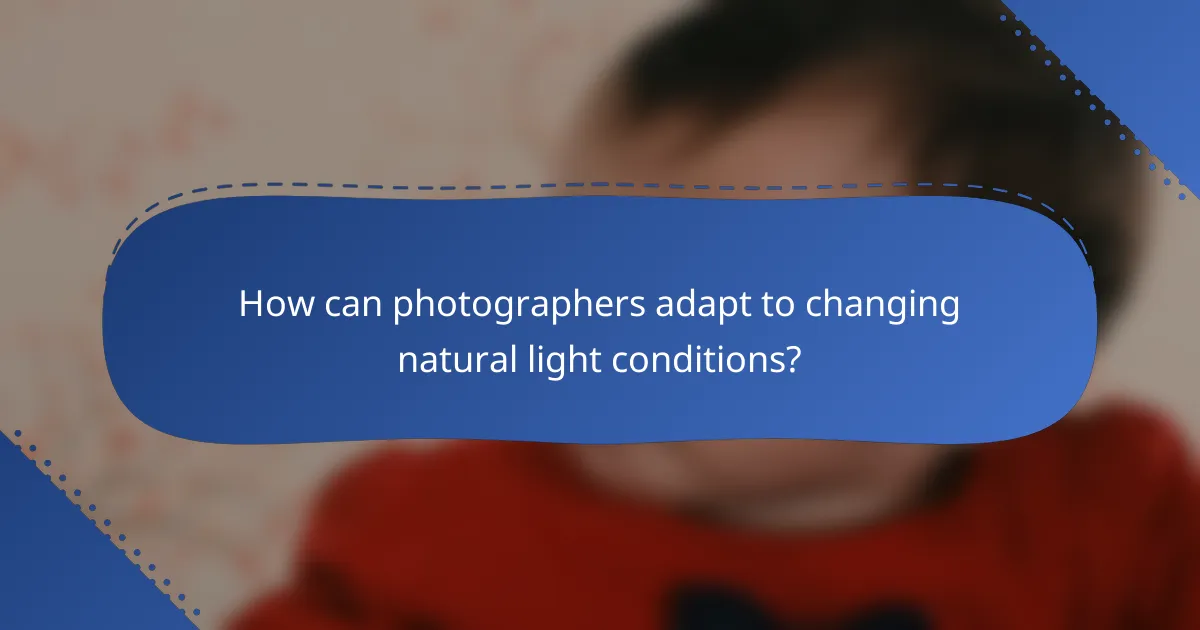Natural light plays a crucial role in photography, as its timing, direction, and quality can dramatically alter the mood and clarity of images. Understanding when to shoot and how to manipulate light can help photographers achieve their desired effects, whether it be through even illumination, added depth, or striking silhouettes. Additionally, the quality of light—its softness, direction, and color temperature—can significantly enhance the overall impact of a photograph.

How does natural light timing affect photography?
Natural light timing significantly influences photography by altering the mood, color, and clarity of images. Photographers must consider the time of day to capture the best light conditions for their subjects.
Golden hour benefits
The golden hour, occurring shortly after sunrise and before sunset, provides soft, warm light that enhances colors and reduces harsh shadows. This period typically lasts about an hour, making it ideal for portrait and landscape photography.
During the golden hour, the sun’s low angle creates a flattering glow on subjects, adding depth and dimension. Photographers should plan shoots around this time to take advantage of the visually appealing light.
Blue hour characteristics
The blue hour takes place just before sunrise and after sunset, characterized by a cool, bluish hue in the sky. This period lasts around 20 to 30 minutes and is perfect for capturing cityscapes and twilight scenes.
During the blue hour, ambient light is low, allowing artificial lights to stand out against the deepening sky. Photographers can create dramatic contrasts and a serene atmosphere by shooting during this time.
Midday light challenges
Midday light, occurring when the sun is high in the sky, presents challenges due to its harshness and strong shadows. This light can wash out colors and create unflattering contrasts, making it less desirable for many types of photography.
To mitigate midday light issues, photographers can seek shaded areas or use reflectors and diffusers to soften the light. Alternatively, shooting in urban environments can provide interesting compositions with shadows and light interplay.

What is the best direction for natural light in photography?
The best direction for natural light in photography depends on the desired effect and subject. Generally, front lighting illuminates the subject evenly, side lighting adds depth and texture, while backlighting creates dramatic silhouettes or highlights.
Front lighting advantages
Front lighting occurs when the light source is directly in front of the subject. This approach is beneficial for capturing clear, well-lit images, particularly for portraits and product photography. It minimizes shadows and highlights details, making it ideal for showcasing colors and textures.
However, it can sometimes result in flat images lacking depth. To counter this, consider using reflectors to bounce light onto the subject, enhancing dimensionality while maintaining the advantages of front lighting.
Side lighting effects
Side lighting is when the light source comes from the side of the subject, creating shadows that add depth and dimension. This technique is particularly effective for landscapes and textured surfaces, as it accentuates contours and details. The angle of the light can dramatically change the mood of the photograph.
To achieve the best results with side lighting, shoot during the golden hour—shortly after sunrise or before sunset—when the light is softer and warmer. Be mindful of the light’s angle, as it can create unwanted harsh shadows if not positioned correctly.
Backlighting techniques
Backlighting occurs when the light source is behind the subject, illuminating it from the rear. This technique can create stunning silhouettes and highlights, adding a dramatic effect to your images. It works well for portraits, especially when capturing hair light or creating a glowing effect around the subject.
To effectively use backlighting, consider using a lens hood to prevent lens flare and maintain image clarity. Adjust your exposure settings to ensure the subject is well-defined against the bright background, and experiment with different angles to find the most compelling composition.

How does the quality of natural light influence images?
The quality of natural light significantly affects the appearance and mood of images. Factors such as softness, direction, and color temperature can enhance or detract from the overall impact of a photograph.
Soft light vs. hard light
Soft light creates gentle shadows and a smooth transition between light and dark areas, often resulting in flattering images. This type of light is typically found during overcast days or in shaded areas. In contrast, hard light produces sharp shadows and high contrast, which can emphasize textures and details, making it ideal for dramatic effects.
To achieve soft light, consider shooting during the golden hour—shortly after sunrise or before sunset—when the sun is low in the sky. For hard light, midday sun is often the best choice, but be mindful of the harsh shadows it creates.
Impact of weather on light quality
Weather conditions play a crucial role in determining light quality. On cloudy days, the diffused sunlight softens shadows and reduces contrast, making it easier to capture even exposures. Conversely, clear skies can lead to stark contrasts and bright highlights, which may require careful exposure adjustments.
Rain or snow can also enhance light quality by reflecting and scattering light, creating a unique atmosphere. Photographers should adapt their techniques based on current weather conditions to optimize their images.
Color temperature variations
Color temperature, measured in Kelvin (K), affects the warmth or coolness of light. Natural light varies throughout the day; morning and evening light tends to be warmer (around 3000K to 4000K), while midday light is cooler (around 5000K to 6500K). Understanding these variations helps photographers select the right settings for their cameras.
To create a specific mood, consider adjusting white balance settings on your camera. For warmer tones, set the white balance to a lower Kelvin value; for cooler tones, increase it. This adjustment can dramatically influence the final image’s feel and aesthetic.

What are the prerequisites for utilizing natural light effectively?
To utilize natural light effectively, understanding the timing, direction, and quality of light is essential. This knowledge helps photographers and designers optimize their work for the best visual impact.
Understanding light sources
Natural light primarily comes from the sun, but its quality and direction change throughout the day. The golden hour, shortly after sunrise and before sunset, offers soft, warm light that enhances textures and colors. In contrast, midday sun can create harsh shadows, which may not be ideal for all subjects.
Cloud cover can diffuse sunlight, providing a softer light that is often more flattering for portraits. Understanding these variations allows you to choose the best times and conditions for your specific photography needs.
Equipment for natural light photography
While natural light photography requires minimal equipment, a few essential tools can enhance your results. A sturdy tripod is invaluable for stabilizing your camera during low-light conditions, especially during the golden hour. Additionally, reflectors can help bounce light onto your subject, filling in shadows and creating a more balanced exposure.
Filters, such as polarizers, can reduce glare and enhance colors, particularly in outdoor settings. Investing in a good lens that performs well in various lighting conditions will also significantly improve your natural light photography experience.

How can photographers adapt to changing natural light conditions?
Photographers can adapt to changing natural light conditions by adjusting their camera settings and utilizing tools like reflectors and diffusers. Understanding the timing, direction, and quality of natural light is essential for capturing the best images.
Adjusting camera settings
To effectively adapt to varying natural light, photographers should modify their camera settings, including ISO, aperture, and shutter speed. For instance, in low light conditions, increasing the ISO can help, but be cautious of noise at higher settings.
Adjusting the aperture allows more light to enter the camera, which is crucial during golden hour or when shooting in shaded areas. A wider aperture (lower f-stop number) can create a shallow depth of field, enhancing the subject while softening the background.
Shutter speed also plays a vital role; slower speeds can capture more light but may require stabilization to avoid motion blur. A good rule of thumb is to use a shutter speed that is at least the reciprocal of the focal length of the lens.
Using reflectors and diffusers
Reflectors and diffusers are practical tools for managing natural light. Reflectors can bounce light onto the subject, filling in shadows and creating a more balanced exposure. They come in various colors, such as silver for a cooler tone or gold for warmth, allowing for creative control over the light quality.
Diffusers, on the other hand, soften harsh sunlight, reducing contrast and creating a more flattering light. They can be as simple as a white sheet or a professional diffusion panel. Positioning a diffuser between the light source and the subject can significantly enhance the overall image quality.
When using these tools, consider the time of day and the light’s direction. Midday sun can be harsh, making diffusers especially useful, while reflectors can be effective during the softer light of early morning or late afternoon.

What are advanced techniques for maximizing natural light?
Maximizing natural light involves strategic planning around timing, direction, and quality to enhance your space or photography. Key techniques include understanding the sun’s path, utilizing reflective surfaces, and adjusting your setup based on the time of day.
Using natural light for portraits
When taking portraits, the best natural light typically occurs during the golden hour, shortly after sunrise or before sunset. This soft, diffused light reduces harsh shadows and enhances skin tones.
Position your subject facing the light source to create a flattering effect, or use side lighting for more dramatic shadows. Avoid direct overhead sunlight, which can create unflattering shadows on the face.
Combining artificial and natural light
Combining artificial and natural light can create a balanced exposure and enhance the overall quality of your images. Use artificial lights to fill in shadows or add warmth when natural light is insufficient.
When mixing light sources, consider the color temperature of both. Adjust your camera settings or use gels on artificial lights to match the natural light’s warmth. This ensures a cohesive look in your photographs.

What are the emerging trends in natural light photography?
Emerging trends in natural light photography focus on the use of natural light to enhance the emotional and aesthetic quality of images. Photographers are increasingly experimenting with different times of day and weather conditions to create unique effects and moods.
Timing
The timing of natural light photography is crucial, as different times of day produce varying qualities of light. The golden hour, shortly after sunrise and before sunset, offers soft, warm light that is ideal for portraits and landscapes. Conversely, midday light can be harsh, creating strong shadows and highlights.
Photographers should plan their shoots around these times to maximize the impact of natural light. Using apps or tools that track sunrise and sunset times can help in scheduling shoots effectively.
Direction
The direction of natural light significantly influences the mood and depth of a photograph. Front lighting illuminates subjects evenly, while side lighting creates texture and dimension. Backlighting can produce dramatic silhouettes and highlights, adding interest to the composition.
Understanding how to position subjects relative to the light source is essential. Experimenting with different angles can yield a variety of effects, allowing photographers to find the most compelling compositions.
Quality
The quality of natural light varies based on weather conditions and time of day. Overcast days provide diffused light that softens shadows, making it perfect for portraits. In contrast, clear days can produce vibrant colors but may require careful management of shadows.
Photographers should assess the quality of light at their shooting location and adjust their techniques accordingly. Using reflectors or diffusers can help manipulate light quality to achieve desired effects.
